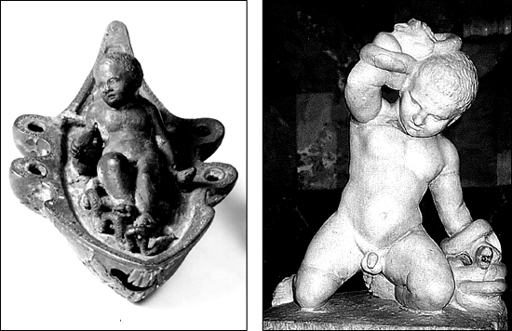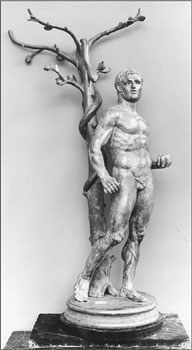Read The Good and Evil Serpent Online
Authors: James H. Charlesworth
The Good and Evil Serpent (35 page)

Figure 54
.
Left
. The Babe Hercules Killing Two Serpents. Courtesy of the trustees of the British Museum.
Figure 55
.
Right
. A Standing Sculpture of the Babe Hercules Killing Two Serpents. Courtesy of the Hermitage. JHC. Both sculptures Roman Period.
As one can imagine, Hercules looms large in ancient iconography.
187
For our focus on serpent symbols, it is imperative to note how frequently Hercules is depicted with serpents. A sixth-century
BCE
bronze statuette, from Doris, Greece, helps us imagine how Hercules was perceived by the Greeks. He wears a lion’s skin tied at the chest and waist with its paws. He is brandishing a club at a hydra. It is a serpent with a goatee, and it rises up to about his waist.
188
According to Pseudo-Apollodorus, when Hercules was only eight months old Hera, incensed by her husband Zeus’ “infidelity,” tried to kill the baby by sending into his bed two large serpents . Hercules strangled them with his bare hands.
. Hercules strangled them with his bare hands.
189
This episode found a life in sculpture, seal impressions, vases, coins, jewelry, clay lamps, and other ceramics. In artwork he is usually depicted as a boy wrestling with one or more serpents, but in some illustrations he is a well-developed man fighting monstrous serpents.
190
Hercules’ last labor was to go to the Garden of the Hesperides to obtain a golden apple, which was the source of immortality. Ironically, the golden apples were a wedding gift from Gaia, the earth god, to Zeus and Hera. The tree was guarded by a large serpent. According to the
Theogony
(lines 333–35), the serpent was the child of Phorkys and Keto.
191
The snake, however, was never given a name (neither was the serpent in Gen 3). It is not clear how and in what ways Hercules accomplishes this feat. In passing, it is interesting to compare this legend with the lore that shapes the story of Gilgamesh and Genesis 3. All three legends or myths include the search for immortality and a serpent. Clearly, the serpent was the quintessential symbol for new life and immortality.

Figure 56
. Hercules in the Garden of the Hesperides with a Serpent in the Tree [BM 827; Neg. No. VI D 321]. Early Roman Period. Courtesy of the Trustees of the British Museum.
Hercules is imagined fighting with serpents
192
or with a hydra.
193
On a Roman sarcophagus an artist has skillfully displayed the sequence of scenes depicting Hercules’ exploits; the serpent is featured prominently.
194
Cerberus
Homer and Hesiod mention a mythological dog that guards the gates to the underworld. Its name is Cerberus. It is depicted in numerous ways. Sometimes it has serpents for tails. At other times it is shown with serpents sprouting from a head or two heads, or with serpents as paws. Cerberus’ mandate was to guard the gates so that no one left the underworld. According to one version of the myth, Hercules persuaded it to come out and Orpheus overcame it with music.
Another version of the myth is represented on a Greek amphora from the late sixth century
BCE
. It envisions Hercules bending down to pet one of the heads of Cerberus. Each head sprouts at least one upraised serpent, and the tail is a serpent. Hercules has bewitched the hound, since after petting its head he will enchain it.
195
Another Greek vase is generic; it depicts Cerberus with serpents on its paws and elsewhere.
196
Laocoon
We have already mentioned the Greek legend about Laocoon. Now, we can dig deeper into this intriguing legend. Laocoon was a priest of Apollo, but he offended the god by breaking his vow of celibacy. Apollo then sent two massive sea serpents to crush him and his two sons, Antiphas and Thymbraeus (Melanthus), as he, as was his duty, was preparing to sacrifice a bull to Poseidon. The names of the two serpents were either Porces and Chariboea or Curissia and Periboea. Another legend, the one mentioned earlier in this book, indicates that he was killed by a Greek god. Now we can state it was Apollo, because he had warned the Trojans not to accept the Greeks’ gift of a wooden horse.
197
The classic source for the Laocoon legend is in the
Aeneid
by Virgil (70#x2013;19
BCE
).
198
According to Virgil, Laocoon warned the people of Troy to be wary of the Greek gift:
Oh, wretched citizens, what wild frenzy is this? Do you believe the foe has sailed away, or do you think any gifts from the Greeks are free from treachery? … Either enclosed in this frame lurk Achaeans, or this [wooden horse] has been built as a war engine against our walls
[aut haec in nostros fabricata est machina muros
], to spy into our homes and come down upon the city from above. [2.42#x2013;47]
199
Many lines later, Laocoon reappears. Notice how Virgil describes the serpents:
Laocoon (Laocon), priest of Neptune [Apollo], as drawn by lot, was slaying a great bull at the customary altars; and lo, from Tenedos, over the peaceful depths—I shudder as I tell the tale—a pair of serpents with endless coils [
immensis orbibus angues
] ascend out of the sea, side by side, and make for the shore. Their bosoms rise amidst the surge, and their crests, blood-red, top the waves. The rest of them skims the main behind and their huge backs curve in many a fold; we hear the sound sent from foaming seas. And now they gain the fields and, with blazing eyes suffused with blood and fire, lick with quivering tongues their hissing mouths. Pale at the sight, we scatter. They in unswerving course speed towards Laocoon; and first each serpent [
serpens
] enfolds in its embrace the youthful bodies of his two sons and with its fangs feed upon the hapless limbs. Then himself too, as he comes to their aid, weapons in hand, they seize and bind in mighty folds; and now, twice encircling his waist, twice winding their scaly backs around his throat, they tower above head and lofty necks. He the while strains his hands to burst the knots, his fillets steeped in gore and black venom; while lifting to heaven hideous cries, like the bellow of a wounded bull that has fled from the altar and shaken from its neck the ill-aimed axe. But, gliding away, the dragon-serpent pair [
gemini … dracones
] escape to the lofty shrines, and seek fierce Tritonia’s citadel, there to nestle under the goddess’ feet and the circle of her shield.
200
This story was well known by the end of the first century
CE
, when the Fourth Gospel reached its second edition. The description of the serpents awakens fear in the reader.
The story of Laocoon is also familiar today because it has become a part of Western culture. One reason for the story’s popularity is the well-known sculpture seen by millions in the Vatican. It was made probably in the second century
BCE
by Agesander, Polydorus, and Athenodorus, three Rhodian sculptors. It depicts in living marble Laocoon vainly struggling against monstrous serpents.
201
Another reason Laocoon is well known today is the famous book by Lessing about the limits of painting and poetry, which was entitled
Laokoon: Oder über die Grenzen der Malerei und Poesie.
This monumental work, which dates from 1766, attempted to distinguish between the art of painting and the art of poetry, and concluded, somewhat idiosyncratically, that poetry, unlike painting, had to do, not with description, but with movement.
The depiction of Laocoon being destroyed by serpents was a popular aspect of Hellenic and Hellenistic culture. It appears on the murals at Pompeii in the Casa del Menandro and can be seen in situ. Another example, also with the bull to be sacrificed in the background, comes from the Casa di Laocoonte in Pompeii and is on display in the National Museum in Naples.
202
The symbolism here is rather uncomplicated. The serpents are not necessarily demonic;
203
but they do appear to destroy and kill. Since they do the will of the god, perhaps a double entendre is present: the serpents represent both good and evil.
Glykon
Glykon is a serpent often depicted with a human-like face.
204
He appears on coins as a large upright serpent.
205
Pseudo-Alexander, whom we will meet in the writings of Lucian, claimed that the serpent he saw was Glykon, a reincarnation of Asclepius. Sometimes Glykon appears with Asclepius; he is depicted as the serpent with anthropomorphic features.
206
As the Greek name Glykon implies, he is “the sweet one.” He is like the serpent often seen with Asclepius, but, unlike that serpent, Glykon is shown with a separate personality and with human emotions. Glykon, the serpent, is thus a positive symbol. He is the personification or incarnation of the concept of health and healing.
Medusa
We have already seen that the Southern Palace in the Hermitage has images of Medusa on its fence. Who was she, and what is the explanation of the serpent imagery?
According to Greek mythology a group of women—Stheno, Euryale, and Medusa, all daughters of Phorcus—were divine and had serpents as hair or in their hair.
207
Frequently they are shown with wings.
208
They are depicted with the tongue sticking out (and even with beards) and are usually unattractive; sometimes, however, they are bewitchingly lovely. They are called Gorgons because occasionally Gorgo is the name of a daughter of Phorcus. In the
Aeneid
, the goddess tosses a serpent
(anguem)
at Alecto (one of the Furies whose head is covered with serpents). The serpent entwines itself around her, and finally its venom “courses through her whole frame” (7.341#x2013;77).
The only mortal, and most famous of the Gorgons, was Medusa. Perseus killed her by cutting off her head. Her head was impaled on Pallas’ spear (i.e., Athena’s spear), and from her blood came Pegasus, the winged horse.
How was Perseus enabled to behead Medusa? An answer may be found in Ovid’s
Metamorphoses.
Perseus beheads Medusa while she and the serpents slept by looking not at her but at the reflection of her in the bright bronze shield in his left hand (
Metam.
4.782#x2013;86).
